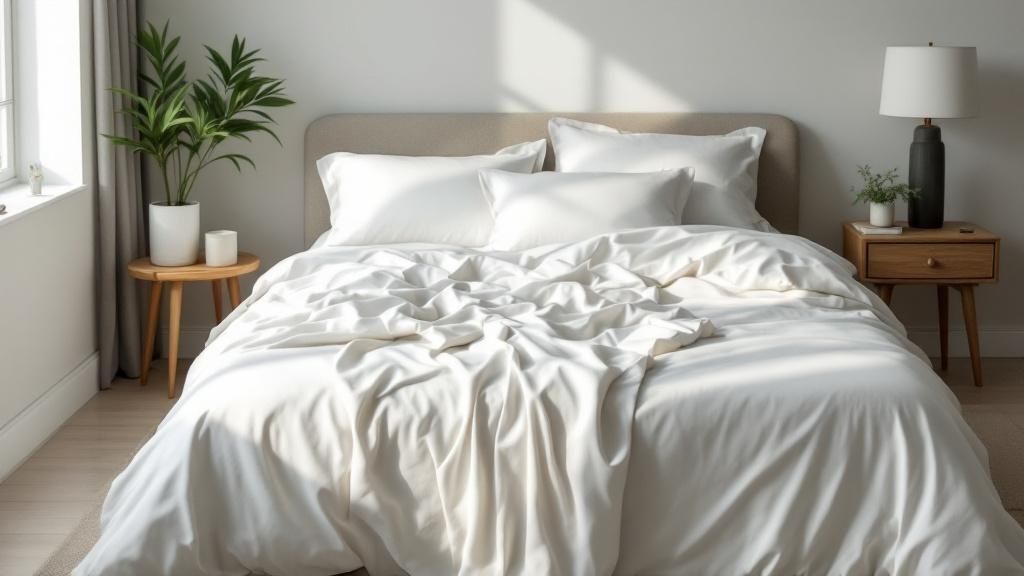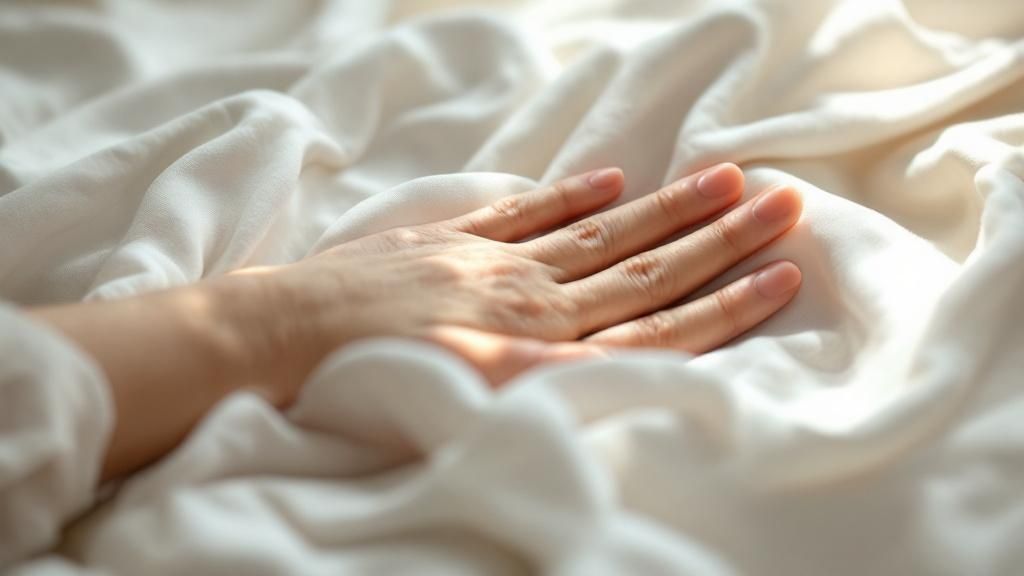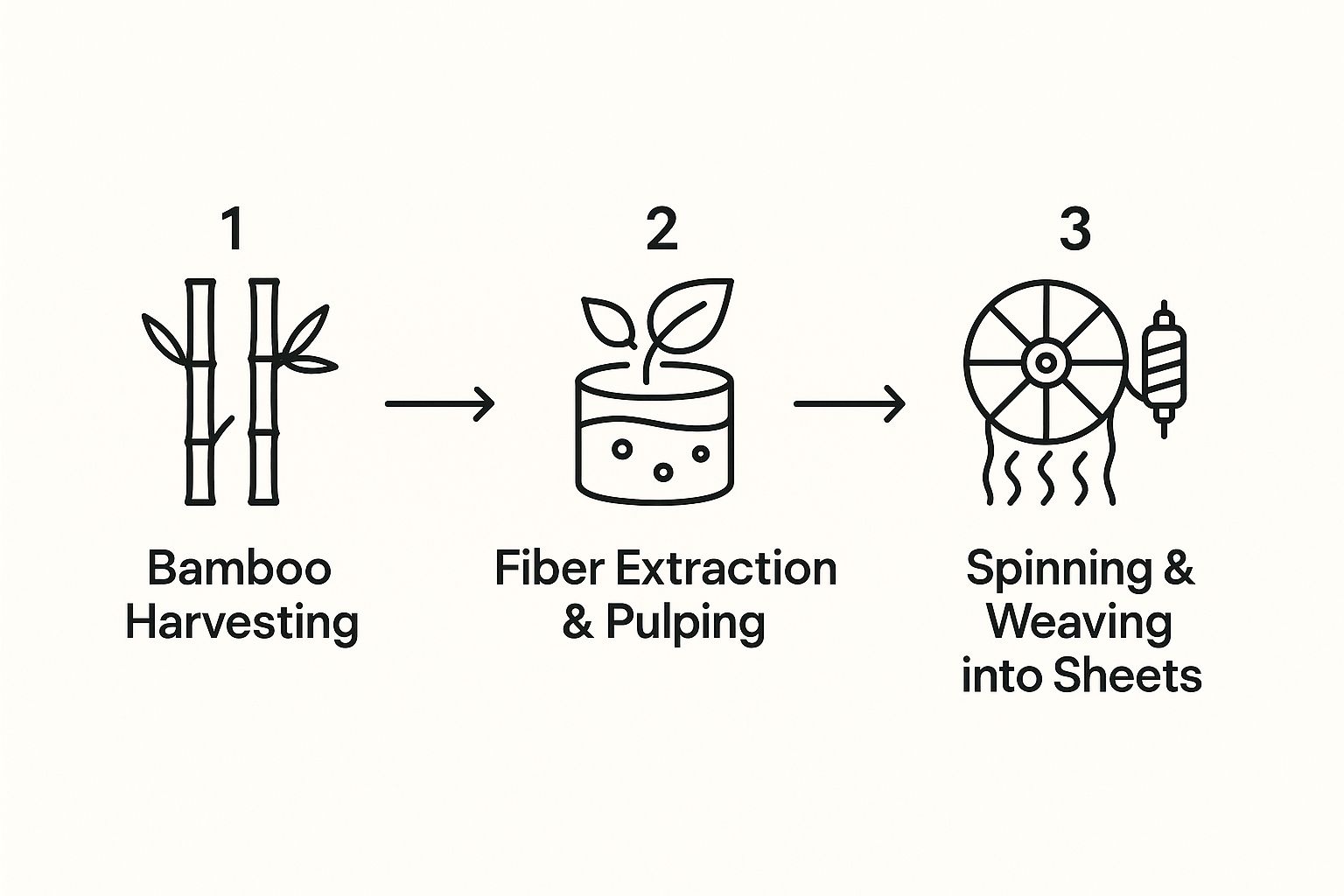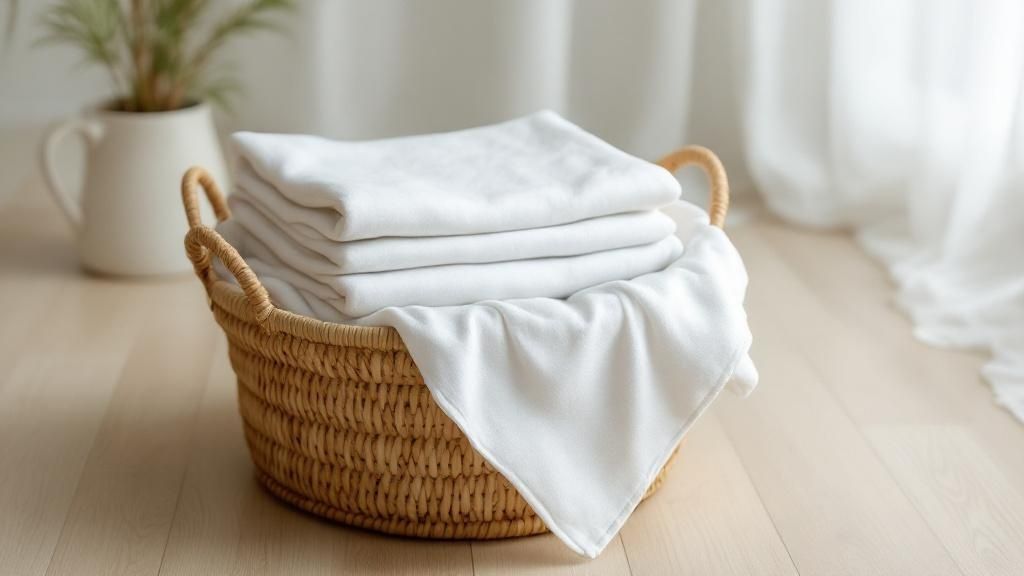Let's be honest, the buzz around bamboo sheets isn't just hype. This bedding, made from the fibers of the bamboo plant, has exploded in popularity for a good reason. People are drawn to its unique blend of silk-like softness, impressive breathability, and eco-friendly origins.
So, What Exactly Are Bamboo Sheets?

When you hear "bamboo sheets," think of a textile woven from the pulp of bamboo grass. This incredibly fast-growing plant is harvested, broken down into a pulp, and then spun into the soft, yet surprisingly durable, fibers that make up the fabric.
It’s a far cry from traditional bedding. Imagine sliding into sheets that feel as luxurious as high-end silk but without the delicate nature or finicky care instructions. That’s the real-world experience that has so many people swapping out their old cotton sets for a better night's sleep.
To really get what makes them special, you need to understand the different types of bamboo fabric you’ll find on the shelf.
Common Types of Bamboo Fabric You'll Find
Not all bamboo fabrics are made the same way. The specific manufacturing process plays a huge role in the final sheet's feel, longevity, and even its environmental impact.
The biggest takeaway here is that the fabric type listed on the label dictates everything from softness to sustainability. Knowing what to look for is the first step to choosing sheets you'll actually love.
Most bamboo sheets you'll come across are made from bamboo viscose, which is a type of rayon. But there are a few other varieties, each with its own unique characteristics.
A Quick Comparison of Bamboo Fabric Types
Understanding the most common bamboo fabrics is key to choosing the right sheets. Here’s how they differ.
| Fabric Type | Manufacturing Process | Key Characteristics |
|---|---|---|
| Bamboo Viscose (Rayon) | A chemical process dissolves bamboo pulp into a viscous solution, which is then spun into fibers. | This is the most common and affordable type. It’s known for being exceptionally soft and silky. |
| Bamboo Lyocell | A "closed-loop" process uses a non-toxic solvent that is almost entirely recycled, making it more eco-friendly. | Very soft but also strong, with fantastic moisture-wicking properties. A great choice for hot sleepers. |
| Bamboo Modal | Similar to the viscose process but produces a fiber with higher wet strength, making it more durable. | Prized for its incredible softness, flexibility, and resistance to shrinking or pilling after washing. |
Now that you can tell the main types apart, you're better equipped to read the fine print on the packaging and find the perfect set for your bed.
What It's Really Like to Sleep on Bamboo

This is where the conversation moves beyond marketing claims and into the real, tangible experience of sleeping on bamboo. It's one thing to hear about it, but it's another thing entirely to feel it. Imagine sliding into a bed that feels like the finest silk but without the fuss or fragility.
One of the first things you'll notice is its remarkable thermoregulating ability. Bamboo fabric is incredibly breathable thanks to the micro-gaps woven into its structure. This design lets excess body heat escape, which is a game-changer for hot sleepers who are tired of kicking off the covers all night. No more sticky, sweaty interruptions.
But here's the clever part: those same properties help it trap a thin layer of warm air when the room is cool, providing just the right amount of insulation on a chilly night. It’s like having a smart thermostat built right into your bedding, constantly adapting to your body.
A Cleaner, Healthier Place to Rest
If you deal with sensitive skin, allergies, or even just the morning sniffles, bamboo sheets can make a world of difference. The fibers are naturally hypoallergenic, meaning they don't give dust mites, dander, and other common allergens a welcome place to live.
The result is a cleaner, fresher sleep environment every time you get into bed. On top of that, bamboo is phenomenal at wicking away moisture.
Unlike cotton, which tends to absorb and hold sweat against your skin, bamboo actively pulls moisture away from your body so it can evaporate. This not only keeps you feeling dry and comfortable but also helps inhibit the growth of bacteria that can cause odors.
Many people have told me they've seen a real drop in skin irritation, and some even notice improvements with conditions like acne after switching. It all contributes to a truly restorative night's sleep.
Why Bamboo Stands Out
The advantages are so much more than just comfort; they're a genuine investment in your well-being. When you break it down, a few key benefits really set bamboo apart:
- Silky Softness: The bamboo fibers are naturally round and smooth, so the fabric glides across your skin without any scratchiness or friction. It's a uniquely gentle feel.
- Built to Last: With the right care, high-quality bamboo sheets are surprisingly durable. They resist pilling and hold their color far longer than many other common fabrics.
- A Sustainable Choice: Bamboo is one of the planet's most renewable resources. It grows incredibly fast, requires very little water, and thrives without pesticides.
These aren't just minor perks. They're practical, everyday benefits that improve how you rest and recover. If you want to get into all the details, you can explore the 20 reasons bamboo sheets are better for a full breakdown of why they've become so popular.
How Bamboo Becomes Your Bedding
Ever wonder how a tough, woody bamboo stalk transforms into the silky-soft sheets on your bed? It’s a pretty incredible journey that starts in a forest and ends in your bedroom. The whole process begins with harvesting, which is where bamboo’s first big advantage comes into play.
Unlike trees that need to be completely uprooted, bamboo is a grass. Harvesters simply cut the stalks at the base, leaving the vast root system untouched. This allows the plant to regenerate on its own without needing to be replanted, which is fantastic for preventing soil erosion and keeping the ecosystem healthy. Once cut, the bamboo is chipped down to get it ready for the next stage.
Turning Tough Stalks Into Soft Fibers
This is where the real magic happens. The most common method used today is the viscose process. Think of it like making a smoothie: the bamboo chips are dissolved in a chemical solution, creating a thick, viscous pulp. This pulp is then pushed through a device with tiny holes (a spinneret) to form fine threads, which are then solidified and spun into yarn.
While this method gets the job done, the traditional viscose process can be harsh on the environment if the chemicals aren't handled responsibly. That's why greener alternatives have popped up.
The gold standard is the bamboo lyocell process. It’s a closed-loop system, which means the non-toxic solvent used to break down the bamboo is captured and reused—at an incredible rate of over 99%. This drastically cuts down on waste and makes it a much more sustainable choice.
This infographic breaks down the key steps from plant to finished product.

As you can see, it takes a few thoughtful steps to turn a raw, natural material into something so luxurious.
Weaving the Final Fabric
Once the yarn is ready, it's time to weave it into the fabric that makes up your bedding. The type of weave has a huge impact on the final feel and performance of the sheets. You’ll typically run into two main kinds:
- Sateen Weave: This is what gives bamboo sheets their signature buttery-smooth, silky feel and a subtle, elegant sheen. It drapes beautifully and feels absolutely incredible against the skin.
- Twill Weave: This weave creates a diagonal pattern, making the fabric exceptionally durable and less prone to wrinkling. It’s still incredibly soft, just with a slightly more substantial feel than sateen.
Knowing how your sheets are made helps you see the bigger picture. It's not just about the final product; it's about the journey it took to get there. For a closer look at how these amazing fabrics compare to the old standby, check out this deep dive into bamboo sheets vs cotton. It gives you the full story so you can choose bedding that feels good in every sense of the word.
How to Choose the Right Bamboo Sheets
Diving into the world of bamboo sheets can feel a bit like learning a new language. With so many options, it’s easy to get lost. But here’s the secret: it’s not about finding the universally "best" sheets, but about finding the perfect sheets for you.
Let's walk through what really matters so you can make a choice you’ll be happy with for years to come.
The first thing you’ll want to consider is the weave, which dictates how the fabric feels against your skin. Most of what you'll find boils down to two types: sateen and twill.
- Sateen Weave: This is the one to get if you're chasing that classic, silky-smooth feeling. Sateen has a lustrous sheen and an almost liquid drape that feels incredibly luxurious.
- Twill Weave: Twill offers a slightly different experience. It's a bit more substantial, with a diagonal rib you can subtly feel, giving it a cozy yet durable texture. It's also less prone to wrinkling, which is always a plus.
What to Look for on the Label
If you've spent years buying cotton, your first instinct might be to look for the highest thread count. With bamboo, you can throw that rule out the window. Bamboo fibers are so much finer than cotton that an ultra-high thread count can actually make the fabric less breathable.
The sweet spot for bamboo sheets is a thread count between 300-500. This range delivers that signature softness without sacrificing airflow.
So, if not thread count, what should you focus on? Certifications. The most important one to find is the OEKO-TEX Standard 100 label.
This isn't just marketing fluff. The OEKO-TEX certification is your assurance that the sheets, from the fabric to the thread, have been rigorously tested and are free from a long list of harmful chemicals. If you have sensitive skin or allergies, this is a must-have.
Beyond the label, pay attention to the small details that signal real quality. Check the hems for strong, even stitching. Look for deep pockets on the fitted sheet—something around 18 inches is ideal to accommodate modern, thicker mattresses without a struggle. Top-tier brands also pre-wash their sheets to minimize shrinkage, so they’ll fit perfectly right out of the package.
Finally, always check the material composition. For the full experience, you'll want sheets made from 100% bamboo viscose or 100% bamboo lyocell. Steer clear of blends that mix in cotton or polyester, as they often compromise the incredible softness and temperature-regulating benefits that make bamboo sheets so popular in the first place.
2. Taking Care of Your Bamboo Sheets for Lasting Softness

You’ve brought home some seriously comfortable sheets, and I know you want to keep them feeling that way. The good news is, with just a little bit of mindful care, your bamboo sheets will stay silky soft for a long, long time. It’s not complicated, but it’s a bit different from how you might wash regular cotton. The key word here is gentle.
If there's one thing to remember, it's this: avoid high heat at all costs. Think of hot water and high-heat dryer cycles as the arch-enemies of bamboo fabric. Heat can damage those fine, delicate fibers, which is what leads to pilling and that disappointing loss of softness.
The Best Way to Wash and Dry
When laundry day rolls around, always reach for the cold water setting on your machine and choose a gentle or delicate cycle. This simple step is probably the most important one for keeping the fibers in prime condition. I also recommend using a mild, liquid detergent. Harsh chemicals, powdered detergents, and anything with bleach can be too aggressive, leaving the fabric feeling stiff and less luxurious over time.
So, what about drying? You’ve got a couple of fantastic, fiber-friendly options.
- Line Drying: Honestly, this is the gold standard. Hanging your sheets to dry, preferably out of direct, harsh sunlight, lets them dry naturally without any heat damage. It’s the gentlest method, hands down.
- Tumble Dry Low: If you're using a dryer, just be sure to select the lowest possible heat setting. An air-dry or no-heat cycle is even better. I like to toss in a few wool dryer balls to naturally soften the sheets, cut down on wrinkles, and even speed up the drying time a bit.
Here's a pro tip I always share: skip the fabric softener and dryer sheets. It's one of the most common mistakes people make. Bamboo is already incredibly soft on its own, and these products just coat the fibers with a residue that clogs the pores of the fabric, making them less breathable and absorbent.
By following these simple practices, you're doing more than just cleaning your bedding—you're preserving the very qualities that made you fall in love with it. For an even more in-depth guide, you can learn more about how to care for your bamboo sheets and keep them feeling brand new. When you care for them right, you'll see that your sheets are a true investment in your sleep quality.
Thinking about making the switch to bamboo sheets? You're not alone, but it's totally normal to have a few questions before you take the plunge. Let's walk through some of the things people wonder about most often so you can feel great about your decision.
Are Bamboo Sheets Better Than Egyptian Cotton?
This is the classic showdown, and honestly, the "better" sheet really depends on what you're looking for. They're just different.
Bamboo has a reputation for its incredible, silky softness. If you've ever run your hand over a high-quality set, you know what I mean. It’s also wildly breathable, which is a game-changer for hot sleepers. If you struggle with night sweats or have sensitive skin, the thermoregulating and hypoallergenic nature of bamboo often makes it the hands-down winner.
On the other hand, a lot of people grew up with and love that classic, crisp feel of high-end Egyptian cotton. If you prefer a bit more weight and a more traditional texture, you might lean towards cotton. But when it comes to pure softness and keeping you cool all night long, bamboo usually comes out on top.
Do Bamboo Sheets Wrinkle Easily?
Yep, they do. This is just a natural part of what makes bamboo fabric so special. The fibers are so incredibly smooth that they tend to crease, especially right out of the wash.
Here’s a little trick I’ve picked up: pull them from the dryer when they're still slightly damp. Don't let them bake until they're bone-dry. Put them straight on your bed, smooth them out with your hands, and let them finish air-drying. Most of those wrinkles will simply fade away within a day or so.
A few wrinkles are a small price to pay for the unmatched comfort of bamboo. Think of it as a sign that the fabric is natural and not loaded with chemical treatments.
How Long Do Bamboo Sheets Typically Last?
If you treat them right, a good set of bamboo sheets will be with you for years. How long they last comes down to two things: the quality of the original fibers and, most importantly, how you care for them.
The secret is gentle washing. Always use cold water on a delicate cycle. And whatever you do, avoid high-heat drying. Heat is the enemy of those fine bamboo fibers.
Stick to mild detergents and cool temperatures, and you’ll keep your sheets soft, strong, and looking great for a long, long time. They're a truly solid investment in your sleep.
Is a Higher Thread Count Better for Bamboo Sheets?
Not really. This is a huge misconception that gets carried over from the cotton world, where thread count is king. With bamboo, the sweet spot is usually between a 300 and 500 thread count.
Instead of getting hung up on thread count, here’s what you should actually look for:
- Fiber Quality: The quality of the bamboo viscose or lyocell is the single most important factor. It determines everything from softness to how well the sheets hold up over time.
- Weave Type: A sateen weave gives you that famous silky, almost shiny finish. A twill weave will have a bit more texture and is known for being extra durable.
- Certifications: Keep an eye out for an OEKO-TEX Standard 100 certification. This is your guarantee that the sheets are free of any harmful chemicals.
The growing popularity of bamboo is part of a much bigger movement toward sustainable living. The numbers back it up, too—the global bamboo industry was valued at around $74.52 billion in 2024 and is only expected to get bigger. If you're curious, you can discover more insights about the bamboo market's growth and see just how much of an impact this resource is making worldwide.
Ready to feel the difference for yourself? Bamtek offers 100% organic bamboo viscose sheets that are OEKO-TEX certified, hypoallergenic, and engineered for a perfect night's sleep. Turn your bed into a cool, soft, and sustainable retreat by checking out the full collection at https://bamtekhome.com.










